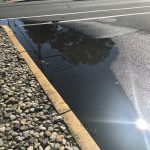New Jersey Future Blog
Eliminating Lead Service Lines: Filling the Funding Gap, One Drop at a Time
May 11th, 2023 by Gary Brune
In early April 2023, the U.S. Environmental Protection Agency (EPA) announced a major change in the allocation of federal funds provided through the Bipartisan Infrastructure Law (BIL) to remove lead service lines (LSLs), replacing a distribution scheme that failed to properly recognize states with older housing stock where the lion’s share of LSLs are likely to exist. This was welcome news to New Jersey, as the state’s allocation will more than double from 1.7% to 3.8%, increasing annual funding for LSL replacement by $35 million (73%), from $48 million to $83 million. This could potentially yield as much as $138 million in additional funds for LSL replacement (LSLR) over the remaining four years of the BIL program. In total, New Jersey seems in line to receive $380 million through fiscal year 2026.

To judge this properly, some context is important. Ranked eighth among states based on its estimated 350,000 LSLs, New Jersey faces a total potential price tag of $2.8 billion to completely remove this public health scourge, which poses a particular threat to young children. While $380 million certainly sounds like a lot of money, it actually represents less than 14% of New Jersey’s total need.
As required by federal law, the initial BIL allocation in fiscal year 2022 was not based on the known or suspected location of LSLs, but rather on all water and wastewater needs (e.g., treatment plants, pumping stations), as reported by states in EPA’s Drinking Water Infrastructure Needs Survey and Assessment (DWINSA) completed in 2018. However, that distribution bore no relationship to the actual need for LSLR projects. As a result, the $48 million appropriated to New Jersey in fiscal year 2022 provided a benefit of only $138 per resident, second lowest amount in the country. A total of 23 other states with significantly fewer LSLs received at least $1,000 per capita. In an extreme example, California received $250 million in fiscal year 2022, or $3,838 per capita for the relatively few LSLs thought to exist in the Golden State.1
As enacted by Congress in 2018, America’s Water Infrastructure Act provided a potential solution by requiring states to estimate their LSLs as part of the 2022 DWINSA survey. However, since most states benefited from the EPA’s original allocation, it was not clear how soon this change would be implemented, and advocacy seemed destined to be a steep, uphill climb.
To its credit, EPA expedited the survey results, ensuring that the revised allocation influenced the funding distribution for the second year of the five year BIL program. And as is true with most successful advocacy efforts, collaboration and partnerships helped amplify the call for change. As part of the Clean Water, Healthy Families, Good Jobs campaign, which advocates for additional water infrastructure funding, New Jersey Future (NJF) joined forces with organizations such as the NJ Laborers Union, the NJ Business and Industry Association, and the NJ Utilities Association. NJF also worked with the Environmental Policy Innovation Center, the Natural Resources Defense Council, and a national forum of advocates from other states with heavy LSL concentrations (e.g., IL, NY, and OH). Information sessions with New Jersey’s congressional delegation, as well as substantive comments submitted to EPA, stressed why it was so important from an efficiency and environmental justice standpoint to stop short changing the states with the greatest need.
Looking to the future, there may be other ways to increase the financial assistance that New Jersey can provide for LSLR projects. The points noted below could serve as the next logical targets for advocacy to address NJ’s funding gap on this important issue:
- Unspent State Revolving Fund (SRF) Balances—To encourage prompt spending, EPA requires states to contract SRF funds for water and wastewater projects within two years, after which balances are reallocated to other states that are ready to spend. The federal BIL funds are administered through the SRF program, and though it is too early to judge how quickly they will be obligated for LSLR projects, it is interesting to note that approximately 4% of all SRF funds were not committed from 2011–2020.2 If that pattern holds true for the $15 billion authorized by Congress for LSLR, $600 million could be available for reallocation among the states.
- Galvanized Service Lines—Unlike New Jersey, some states do not mandate the complete replacement of galvanized service lines, despite the fact that they are a known source of lead in drinking water. Therefore, EPA’s current funding formula does not take those lines into account. Since EPA estimates that New Jersey may have over 180,000 galvanized lines, this places the state at a distinct disadvantage for having done the “right thing” to protect public health.
- American Rescue Plan (ARP)—In New Jersey, over $1 billion in federal ARP funding remains unallocated. While $300 million in ARP funds was appropriated to water infrastructure last year, that was largely directed to combined sewer overflows. In his Fiscal Year 2024 Budget Message, Governor Murphy committed to increase support for water infrastructure from ARP and other sources, providing another potential solution to get the lead out of drinking water.
__________________
1IIJA Lead Service Line Replacement Funding Distribution (nrdc.org)
2Uncommitted State Revolving Funds (duke.edu)
Related Posts
Tags: federal funding, funding, Funding for Lead Service Line Replacement, lead, Lead free New Jersey, lead in drinking water, lead in water, lead service line, lead service line replacement
















